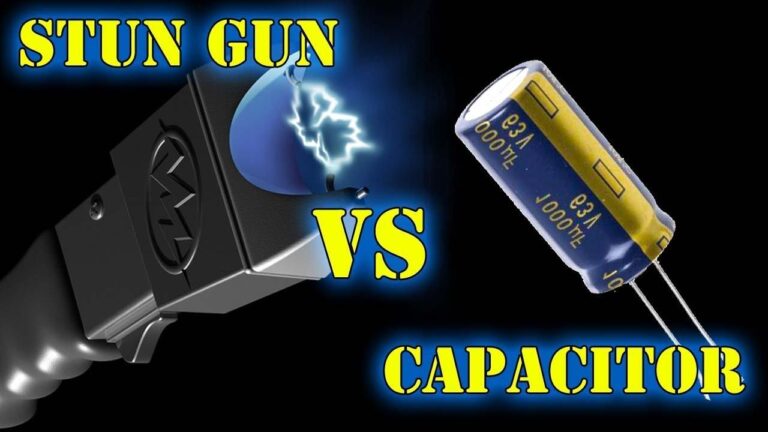Table of Contents
- Understanding the Role of Capacitors in Stun Gun Circuit Design
- Exploring Capacitor Types and Their Impact on Stun Gun Performance
- Optimizing Capacitor Selection for Reliable and Efficient Power Delivery
- Maintenance Tips to Ensure Capacitor Longevity in Stun Gun Devices
- In Summary
Understanding the Role of Capacitors in Stun Gun Circuit Design
Capacitors are the unsung heroes in the circuitry of stun guns, acting as essential energy reservoirs that store and release electrical power in controlled bursts. Unlike batteries, which provide a steady flow of current, capacitors accumulate charge quickly and discharge it almost instantaneously. This rapid release is what generates the high-voltage shock necessary for a stun gun’s effectiveness. In essence, the capacitor’s ability to hold and dump large amounts of energy in microseconds is what transforms low-voltage input into a powerful, disabling electric shock.
When designing stun gun circuits, several capacitor attributes are critical to enhancing performance and safety:
- Capacitance Value: Determines how much charge the capacitor can store, directly influencing the stun duration and intensity.
- Voltage Rating: Ensures the capacitor can handle the high-voltage spikes without breaking down.
- Recharge Rate: Affects how quickly the capacitor can be ready for the next discharge, impacting the stun gun’s firing rate.
By balancing these factors, engineers craft stun guns that are both powerful and reliable, maximizing their defensive potential while maintaining circuit integrity.
Exploring Capacitor Types and Their Impact on Stun Gun Performance
When it comes to selecting the right capacitor for stun gun circuits, understanding the differences between capacitor types is crucial. Electrolytic capacitors, known for their high capacitance values, are often utilized to store significant electrical energy that can be rapidly discharged to produce a powerful shock. These capacitors excel in providing large bursts of current, which directly influences the strength and duration of the stun gun’s output pulse. However, their relatively larger size and slower charge/discharge cycles can affect the unit’s overall responsiveness and portability. On the other hand, film capacitors offer superior stability, low internal resistance, and faster discharge rates, making them ideal for circuits where rapid, repeated pulses are necessary without degradation over time.
Beyond the capacitor type, the capacitor’s voltage rating and capacitance value also play vital roles in defining stun gun performance. Higher voltage ratings enable the capacitor to withstand the intense voltage spikes typical in stun gun circuits, preventing premature failure and ensuring consistent operation. Meanwhile, capacitance directly impacts the energy stored-the greater the capacitance, the more intense the shock delivered. Designers often balance these variables using the following criteria:
- Energy Storage Capacity: Determines the intensity of the stun effect.
- Charge and Discharge Speed: Influences the stun gun’s readiness and frequency of use.
- Size and Weight: Impacts the ergonomics and portability of the device.
Optimizing Capacitor Selection for Reliable and Efficient Power Delivery
Selecting the right capacitor is crucial to ensuring your stun gun circuit delivers reliable and efficient power. Factors such as capacitance value, voltage rating, and equivalent series resistance (ESR) directly influence how well the capacitor can store and release energy during high-voltage discharges. Typically, capacitors with low ESR and high voltage tolerance are preferred because they can handle rapid charge-discharge cycles without significant energy loss or overheating. Ceramic and film capacitors often outperform electrolytic ones in stun gun applications due to their stability and endurance under stress.
When optimizing capacitor selection, consider these key points:
- Capacitance and Voltage Ratings: Ensure the capacitor can sustain the stun gun’s voltage spikes and store enough charge for a powerful output.
- Physical Size and Form Factor: Compact capacitors facilitate better integration within the circuit’s limited space.
- Durability and Longevity: Components that withstand repeated charge cycles guarantee consistent performance and increase the device’s lifespan.
- Temperature Stability: Capacitors that maintain characteristics under heat prevent circuit failures in demanding usage conditions.
Maintenance Tips to Ensure Capacitor Longevity in Stun Gun Devices
To maximize the lifespan of capacitors in stun gun circuits, regular inspection is essential. Avoid exposure to extreme temperatures-both heat and cold can degrade capacitor materials over time. Keep the device stored in a cool, dry place to prevent moisture ingress, which can cause corrosion and reduce capacitance. Additionally, periodically check for any visible signs of damage such as bulging, leaking, or discoloration in the capacitor casing. These early warnings can help you replace faulty components before they compromise device performance or safety.
Proper electrical handling also plays a critical role in capacitor longevity. Make sure the stun gun’s power source delivers consistent voltage without spikes or surges, which can stress and prematurely wear out the capacitor. When performing maintenance or repairs, always discharge capacitors safely to avoid accidental shock and damage. Incorporate these best practices into your routine care plan to ensure the capacitors-and your stun gun-continue to operate reliably over time.
In Summary
In conclusion, capacitors play a crucial role in the operation of stun gun circuits by efficiently storing and rapidly releasing electrical energy to deliver that powerful, disabling shock. Understanding how these components work not only sheds light on the inner mechanics of stun guns but also highlights the importance of capacitor selection and circuit design in ensuring both effectiveness and safety. Whether you’re an electronics enthusiast or simply curious about the technology behind stun guns, appreciating the function of capacitors offers valuable insight into the sophisticated engineering that powers these devices. Stay tuned for more deep dives into the fascinating world of electrical components and their real-world applications!Check Our Other Blogs
- StunGun – Your Trusted Source for Stun Guns, Laws, and Self-Defense Tips
- PepperSprayLaws – Your Trusted Resource for Pepper Spray Information
- StunGunLaws – Your Trusted Guide to Stun Gun Legality and Safety





